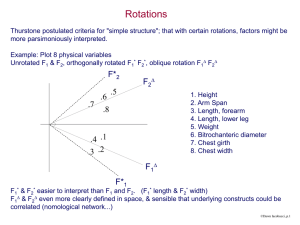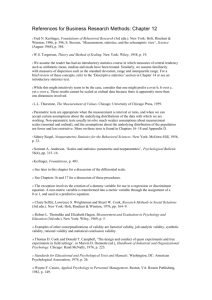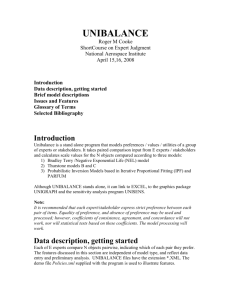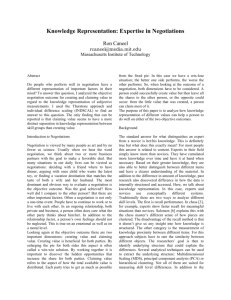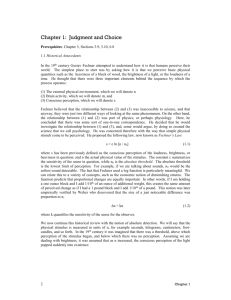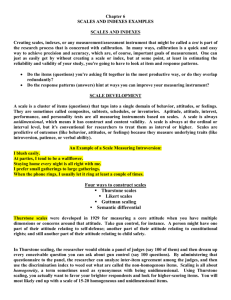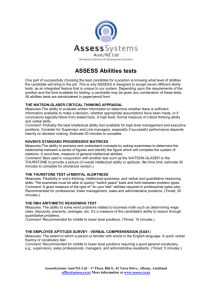Lyle Jones
advertisement
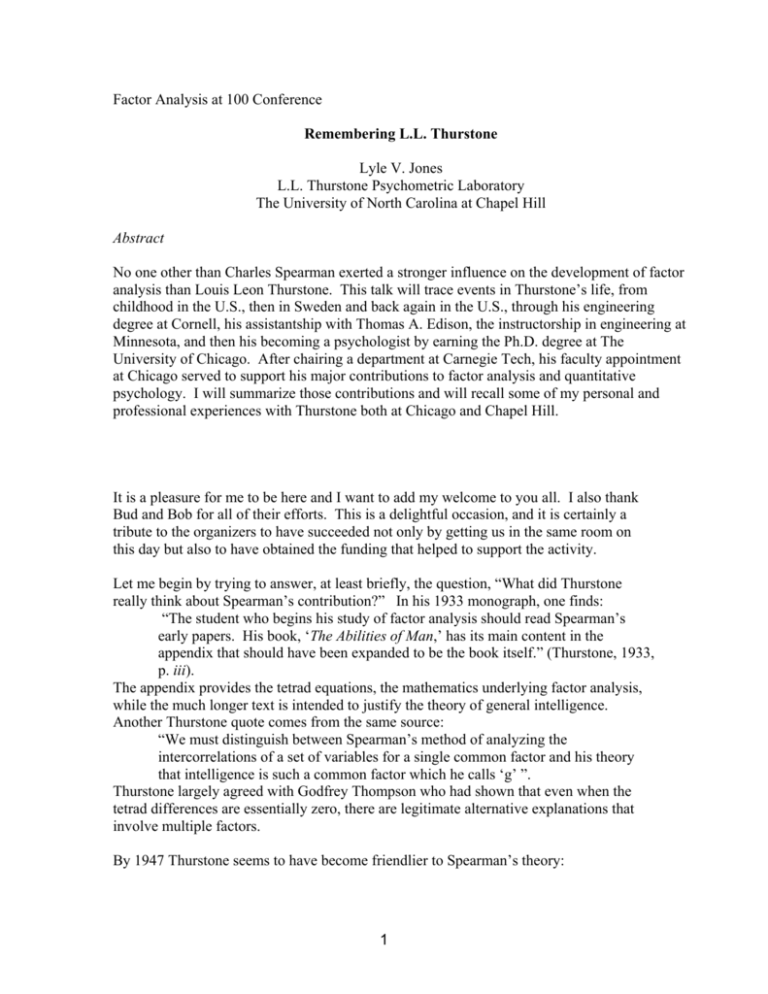
Factor Analysis at 100 Conference Remembering L.L. Thurstone Lyle V. Jones L.L. Thurstone Psychometric Laboratory The University of North Carolina at Chapel Hill Abstract No one other than Charles Spearman exerted a stronger influence on the development of factor analysis than Louis Leon Thurstone. This talk will trace events in Thurstone’s life, from childhood in the U.S., then in Sweden and back again in the U.S., through his engineering degree at Cornell, his assistantship with Thomas A. Edison, the instructorship in engineering at Minnesota, and then his becoming a psychologist by earning the Ph.D. degree at The University of Chicago. After chairing a department at Carnegie Tech, his faculty appointment at Chicago served to support his major contributions to factor analysis and quantitative psychology. I will summarize those contributions and will recall some of my personal and professional experiences with Thurstone both at Chicago and Chapel Hill. It is a pleasure for me to be here and I want to add my welcome to you all. I also thank Bud and Bob for all of their efforts. This is a delightful occasion, and it is certainly a tribute to the organizers to have succeeded not only by getting us in the same room on this day but also to have obtained the funding that helped to support the activity. Let me begin by trying to answer, at least briefly, the question, “What did Thurstone really think about Spearman’s contribution?” In his 1933 monograph, one finds: “The student who begins his study of factor analysis should read Spearman’s early papers. His book, ‘The Abilities of Man,’ has its main content in the appendix that should have been expanded to be the book itself.” (Thurstone, 1933, p. iii). The appendix provides the tetrad equations, the mathematics underlying factor analysis, while the much longer text is intended to justify the theory of general intelligence. Another Thurstone quote comes from the same source: “We must distinguish between Spearman’s method of analyzing the intercorrelations of a set of variables for a single common factor and his theory that intelligence is such a common factor which he calls ‘g’ ”. Thurstone largely agreed with Godfrey Thompson who had shown that even when the tetrad differences are essentially zero, there are legitimate alternative explanations that involve multiple factors. By 1947 Thurstone seems to have become friendlier to Spearman’s theory: 1 “It seems likely that a second-order general factor, determined from correlated primaries, may turn out to be Spearman’s general intellective factor ‘g’.” (Thurstone, 1947, p. viii.) Thus, while appearing initially to have questioned the construct of general intelligence -or at least the evidence for g – Thurstone later seems more accepting so long as g may be conceived as being divisible into correlated primary factors. What I intend to do now is to highlight some of the aspects of Thurstone’s life which I think influenced both his personality and the nature of his contributions. I will comment briefly on some of those contributions. Darrell Bock, I expect, will do a much more thorough job later this morning. Then I’ll recall some personal experiences from the years 1950 to 1955 when I was working fairly closely with Thurstone. Thurstone’s childhood was quite unusual. I do believe that it had a lasting influence on him. He was born Louis Leon Thunström in Chicago in the month of May in 1887. He began school in Berwyn, Illinois, but stayed only for one year until moving with his family to Centerville, Mississippi. His father was a Lutheran minister. Both his mother and father had emigrated from Sweden. When he was eight years old, the family moved from Mississippi to Stockholm where he again attended school, first a public school and then a private boys’ school. Lacking confidence in his linguistic skills, he became immersed in the study of Swedish. Then, after only six years, his family once again immigrated to this country. Thurstone was by that time 14 years old and did not want to come. He told his parents that he would not accompany them unless he could take his favorite books with him. They could not afford the cost of adding books to their luggage, but his mother said he could take three books if he carried them on board the ship. He brought with him his Euclid geometry, a world atlas, and a large encyclopedia of philosophic essays, carrying those on and off the ship when the family returned to this country. Relearning English became a serious challenge to him then, and it remained so. When he entered high school in Jamestown, New York, his high school principal became his tutor to help him feel more comfortable with the English language. He won a 30-dollar prize in a geometry contest as a sophomore in high school with which he purchased a Kodak camera (and photography became a lifelong interest of his) and a bicycle. At about that time, his first publication appeared as a letter to the editor in the American Scientist (Thunström, 1905). It proposed a method of diverting the Niagara River for several hours each day in order to provide a source of power without disrupting the beauty of Niagara Falls. While he still attended high school, his parents changed the family surname from Thunström to Thurstone, a change designed to make social life easier for their son and his younger sister. As a graduation requirement, every senior in his high school had to give a five-minute talk to an audience of several hundred students. Thurstone told the principal that he would not be able to graduate from high school if required to give that talk. His accent still bothered him a great deal. After some discussion the principal excused him from the requirement. 2 After high school graduation, he enrolled at Cornell in the School of Engineering. While a student at Cornell, he invented and patented a movie camera and projector that, by using rotating mirrors, avoided the flicker that was characteristic of movies in the early decades of the last century. Indeed, he demonstrated the camera for Thomas A. Edison at Edison’s lab in New Jersey. Edison was intrigued with it, considered a plan to build and to make the camera commercially available, but Edison’s lab already had been designed to build Edison cameras, so Thurstone was complimented and thanked and he returned to school where he earned the Master of Engineering degree in 1912. He then was invited by Thomas Edison to become Edison’s laboratory assistant, and he spent the summer of 1912 in that capacity. He later recalled of Edison: He displayed a “startling fluency of ideas, which often ranged far from the immediate problem. He seemed to have an absolutely endless array of stories; very few of them were fit for publication. If problem-solving ability is to be studied scientifically and experimentally, it will be advisable to include studies of different kinds of fluency”. (Thurstone,1952, p. 299). He was impressed by Edison’s habit of discarding ideas that had been tried and found not to work. With no hesitation, Edison simply tried something else. It is said of Edison that after 10,000 unsuccessful efforts to develop a storage battery, a friend expressed sympathy for his failure. “I have not failed,” replied Edison. “I have just discovered 10,000 ways that don’t work.” Whether copying those habits or having had them come naturally to him, Thurstone did develop similar ones. When he became dissatisfied with a draft manuscript, he would not attempt to repair it through revision as many of us do, but he discarded it and started afresh. In the fall of 1912 Thurstone became an instructor in geometry at the Engineering School of the University of Minnesota and, as at Cornell where he had taken courses with E. B. Titchener and Madison Bentley, he affiliated with a couple of psychology professors at Minnesota even though he was teaching engineering. He was interested in how users of new tools developed by engineers learned to effectively employ those tools, how they developed eye-hand coordination, for example; can the ways by which people learn to use engineering devices be expressed as mathematical functions? He was so interested in such problems that in 1914 psychology professors Herbert Woodrow and J. B. Miner at Minnesota helped him become a graduate student at the University of Chicago. As a graduate student in Chicago, he first enrolled in the College of Education with Professor Charles Judd, at that time chair of the Department of Educational Psychology. Thurstone wrote about his experience as a graduate student: “I recall one of my first impressions of graduate students of psychology. When they were asked a question, they would start to talk fluently, even when they obviously knew nothing about the subject. I was sure that engineers had higher standards of intellectual honesty. One of my first courses was called advanced educational psychology and it was taught by Professor Judd. I used to wonder what the elementary course could be like if the course I was taking was called advanced. I soon became accustomed to the fact that prerequisites did not mean anything and that there was no real sequence of courses in psychology, even 3 though they were listed by number and title to give the appearance of a sequence, in which one course was supposed to build on another. I never had an elementary course in psychology or in statistics. My first degree was M.E. and I was never flattered when it was interpreted at Chicago as a master’s degree in Education.” (Thurstone, 1952, p. 300). After just one term, Thurstone shifted to Psychology from Educational Psychology and worked with James Rowland Angell, a psychologist who was chairing the department at that time. (Angell later became dean of the faculties and then acting president at Chicago, President of the Carnegie Corporation, and then President of Yale from 1921 until his retirement in 1937.) Only a year after Thurstone began his graduate work, Walter Bingham, who had earned a Ph.D. at Chicago earlier, visited the Psychology department. Bingham was the charter head of the Division of Applied Psychology at the Carnegie Institute of Technology and he sought to employ an assistant to come to work with him at Carnegie Tech. He chose Thurstone so, after a year at Chicago, Thurstone moved to Carnegie Tech and became Bingham’s assistant where also he wrote his Ph.D. dissertation on mathematical functions of learning, later published as a Psychological Monograph. Upon receipt of the Ph.D. in 1917, Thurstone became an instructor at Carnegie Tech. (Because he was underweight, Thurstone had become exempt from the draft of World War I.) The next year he became assistant professor, the next year associate professor, the next year professor and chair of the Department of Applied Psychology. His work there focused on the development of vocational classification tests. From 1919 to 1923 he developed tests of intelligence, clerical skills, engineering aptitude, ingenuity, often to meet needs in both the military and the civil service. In 1923 the department at Carnegie Tech was abolished. Thurstone spent 1923-24 in Washington, D.C. at the Institute for Governmental Research, a non-profit organization funded largely by the Carnegie Corporation. He was charged with improving U.S. civil service examinations. Thelma Gwinn had come from Missouri as a graduate student in his department at Carnegie Tech in 1920. Thelma had a bachelor degree from the University of Missouri in German language and had aspired to be a German teacher. World War I had not served to encourage the teaching of German in American high schools, and she found no opportunity for employment. She was advised by one of her professors that even though Carnegie was an engineering school and there may not be many women there, he knew of a program that might interest her. She had a strong mathematical background. So she enrolled in Thurstone’s department at Carnegie Tech. She earned a master’s degree in 1923, and became his assistant in Washington, D.C. for the following year. The Institute happened to be in the same building, I think on Dupont Circle, where the American Council of Education offices were. ACE was in the process of developing aptitude tests for high school students and college freshman to provide guidance to students about selecting a college major, and the Thurstones frequently discussed that program with ACE personnel. At the end of that year Leon and Thelma were married and he accepted employment as a faculty member at Chicago in 1924. 4 The contact with ACE was of considerable importance, because from 1924 to 1945 Leon and Thelma Thurstone were continuously supported by ACE to create annual tests for high school seniors and college freshman. Every year they produced a new edition with new norms. That work served to maintain their interests in testing practice and theory. In 1924 Thurstone designed and taught what he considered to be the world’s first college course in test theory. The period 1925 to1930 constituted years in which Thurstone produced remarkable papers in psychophysical measurement and psychological scaling based upon assuming a normal distribution of some trait and characterizing a person’s level on that trait as a deviation from the mean in standard deviation units. In 1929 a new president was appointed at the University of Chicago, Robert Hutchins, who at the time was 29 years old. Thurstone was 42. One of Hutchins’ innovations at Chicago was to provide course credit by examination rather than by enrolling in every required course. Hutchins appointed Thurstone as the chief examiner for devising, scoring and maintaining that program. Among the examiners hired by Thurstone, were Dorothy Atkins, Harold Gulliksen, Paul Horst, Marion Richardson, John Stalnecker, Dael Wolfle, among others that many here would recognize as having made substantial contributions to psychometrics. Thurstone’s office was not in the psychology building, but in the Social Science Research building in Chicago. Charles Merriam was the chairman of political science and offered not only an office, but work rooms to Thurstone. One day in the early 1930’s Thurstone came home to tell Thelma, “ I think I will establish a psychometric laboratory and I will be its director”. Thelma said, “You know you can’t do that. The chairman would not approve of that, the dean would not approve.” Thurstone said, “I know. That’s why I put the sign on the door this afternoon.” I recall that sign, “The Psychometric Laboratory,” from the time of my arrival at the University of Chicago in 1950. Nobody had ever challenged it, and that is the history of the way the Psychometric Lab was established. Paul Horst was a student of Thurstone’s in the 1930’s and he recalls walking across campus with Professor Thurstone when Leon said, “Paul, we have to do something about Spearman’s general factor theory.” Thurstone was skeptical of the evidence for g. If disturbance factors turned out not to be greater than two probable errors away from zero, they were ignored in favor of substantiating the general factor notion. Because evidence was based on a small number of tests and a rather small number of subjects, that criterion for accepting g was overly lenient. Thurstone felt that his notion of rotation to simple structure was his greatest contribution to factor analysis. Of course he also emphasized the importance of using communalities rather than ones (or total variance) when working with the correlations that were needed in order to establish structure among abilities. In the 1930’s a representative from the Works Progress Administration, the WPA of the Roosevelt Administration contacted the Thurstones. The WPA provided federal funds 5 for the hiring of unemployed people and included a higher education section, the section that approached the Thurstones. They were asked if they could use some assistance in the laboratory, could they hire 100 people? Thurstone said “No, not 100 people, but maybe as many as 20.” The WPA provided federal funds for the hiring of unemployed people and had a higher education section, the section that approached the Thurstones. Indeed, they did hire as many as 20 assistants. Among those helpers, Thelma Thurstone said there were three Ph.D.’s in mathematics. The assistants were unemployed but highly talented young men and women, victims of the depression in the mid-1930s. Ledyard Tucker had earned an engineering degree at Colorado and was among those hired by the Thurstones. That work group helped to construct, administer, score, and analyze results from the 57-test battery that provided data for the publication in 1938 of Psychometric Monograph Number 1, entitled Primary Mental Abilities. The project was based on data from about 300 subjects, a fairly substantial sample size at that time. All were University of Chicago freshmen and engaged in 15 hours of testing (during a vacation week); they were paid for their time, and 92% finished all of the tests. It is interesting that near the end of Psychometric Monograph Number 1 is a discussion about how the results might be used. Thurstone discusses the relation between a student’s ability profile and that student’s expressed vocational interests. He reports that high verbal, word fluency and low number ability characterizes people with interests in advertising, writing tasks, and journalism. Some students with high verbal ability, high perceptual ability, but low reasoning scores expressed an interest in acting. He found that people with engineering interests were high in deduction, space, and number. Interests in chemistry or geology were associated with high space skills. These appear to be cited as suggestions for further research. Paul Horst was well aware of this work. Paul finished his Ph.D. with Thurstone in 1935. He told Thurstone, “I am going to take a job at Proctor and Gamble in Cincinnati, Ohio.” Thurstone said “But, Paul, you are an academic type”. Paul said, “Yes I know it. I am going to get rich and then I am going to retire to a university professorship”. And that is precisely what he did. From 1935 to 1947 Paul saved his money as a Proctor and Gamble industrial psychologist. He then retired from P & G to join the faculty at the University of Washington where I was a student, so I took his courses the first year he was there. He also was Director of the Counseling Center at the U of W. There, in the tradition of Thurstone, he developed a test battery designed to yield vocational advice to students. His test, by legislative action in the state of Washington, became a required battery for all high school seniors. Only in recent years has that law been rescinded (and some believe that to have been a disservice to graduating high school students in the State). Thurstone was not always gentle with his critics. In fact he could become a bit defensive. He wrote “it has been a mystery to me why the fundamentally simple notion which I call simple structure, has been twisted around by some critics as the most inconceivable nonsense.” (Thurstone, 1947, p. v). “Factor analysis has not been generally accepted by mathematical statisticians. When the statistician turns his attention to the multiple factor problem, he must deal with the communality concept and its effect on the rank of the correlation matrix. If he denies this problem, he not only admits his inadequacy but also 6 his failure to understand the problem. ... he will not solve the problem by laughing it out of court.” (p. x). He continues, “The statistician must understand this problem of oblique reference axes and associated scientific concepts. The statistician must not impose the arbitrary restriction that our scientific concepts in the description of people must be uncorrelated either in the experimental sample or in the general population.” (p. x). Harold Hotelling had developed the principal components method for reducing variancecovariance matrices. A failure to recognize the different goals of the “competing” methods had led to some antagonism between Hotelling and Thurstone. However, by the time Thurstone came to Chapel Hill in 1952, Hotelling, already at UNC, was a strong supporter of his appointment and the two got along well. Thurstone also could be generous with his praise. Citing again from the introduction to the 1947 Multiple-factor Analysis, “A special acknowledgement is due Mr. Ledyard Tucker, who was my chief assistant for a number of years. His thorough mastery of the theory and computational methods of multiple-factor analysis has been of the greatest aid not only in preparing the present manuscript but also in the numerous factorial experiments that have been made here in recent years.” Then he wrote, “My principal acknowledgement is to my wife, who has been a partner in the formulation of each problem, as well as in all the experimental studies of this laboratory.” (p. xiii). Thurstone received many honors. He was president of the Midwestern Psychological Association in 1930 and president of the American Psychological Association in 1932. The Psychometric Society was founded in 1935-36, and he was its first president. He was elected to the National Academy of Sciences in 1938, then as fellow of the American Academy of Arts and Sciences, as fellow of the American Statistical Association, and as honorary fellow of the British Psychological Society. It is of interest to note that John B. Carroll was a student of B.F. Skinner in the psychology department in Minnesota and visited Chicago to work with Thurstone in 1940 where he wrote his doctoral dissertation. Upon return to Minnesota, he was Skinner’s first Ph.D. Carroll’s contributions not only to psychometrics but to psycholinguistics and language learning were very much influenced by his work with Thurstone.. When I was a PhD student at Stanford, I wrote to Thurstone in 1949 asking him whether I could spend a year working with him at Chicago were I to be awarded a National Research Council postdoctoral fellowship. He wrote back to say that that would be fine. In early spring of 1950 as I was trying to complete my dissertation, I had offers from Harvard as a instructor, and from both Kansas and Hawaii as an assistant professor. These were three distinctly different offers and I had not become enthusiastic about any of them. When a letter finally came from NRC announcing a fellowship award, I was pleased to move to Chicago to work with Thurstone in the company of several other postdoctoral fellows. Allen Edwards, a University of Washington professor who taught me my first psychological statistics course, was a post-doc that year, as were James Birren, the gerontologist from the University of Southern California, Jean Cardinet from Paris, Per Saugsted from Norway, and Horace Rimoldi from Argentina.. Of course, we all were students in Thurstone’s class on Factor Analysis and we also become close friends. 7 My plan at Chicago was to analyze data at several ages from the standardization of the 1937 Stanford-Binet intelligence test, intending to develop oblique-structure factor solutions, based on graphical transformations. Thurstone and I would meet weekly so that we could review results from the graphs that I had created during the prior week and he could then advise me about fruitful next steps. I learned that he could anticipate far better than I the likely influences of a two-dimensional transformation on the simple structure from the perspective of other (hidden) dimensions. His visualization skills were exceptional. In early 1951 I learned that Karl Holzinger was offering a course on factor analysis in the College of Education. I thought that I should enroll in that course, but at the last moment decided to ask Professor Thurstone if that would be okay. He looked at me with disbelief and said, “Certainly, Jones, if you want to, but you’ll find it to be a total waste of time.” . I did attend the class for several meetings, but gave up after about three weeks. Later in 1951 I was weighing faculty offers from Cornell, Johns Hopkins, and Michigan, not certain about which of them to accept. It was a total surprise to me when Thurstone asked me, “Would you like to become a faculty member here?” I said “Oh, yes indeed!” I did so and worked with him as a faculty colleague in 1951-1952. Another surprise arose a year later when he informed me that faculty members at the University of Chicago could not be employed after age 65, that he was 65 and that he was taking another job. He had offers from the University of Washington, California at Berkeley, and the University of North Carolina in Chapel Hill. The selection of UNC was based largely on the simultaneous offer of a faculty appointment to Thelma Thurstone, something that had never been possible because of nepotism policies at Chicago. At Chapel Hill, she became a professor in education and a research associate in the Psychometric Lab), and he was appointed professor in psychology. The Psychometric Laboratory occupied a separate two-story building, Nash Hall near the Carolina Inn. The Thurstones built a house near campus with a seminar room similar to the one in their home in Chicago that was famous for its Wednesday evening talks, usually from visitors, with an invited guest list of 30 – 35 people. Thelma served coffee and pastry after the talk, at Chapel Hill as well as in their Chicago home. From 1952 to 1955, Thurstone and I continued to engage in joint research, mostly with support from grants and contracts that I had inherited from him and renewed at Chicago while he was at Chapel Hill. In July of 1955 Thurstone wrote asking if I would visit for a few days the Thurstone family at their summer home near Traverse City, Upper Michigan. I did so in August. The Thurstone sons tried to teach me to water ski. I didn’t master that challenge, but did have good fun and good companionship. Then Thurstone took me aside to give me some advice. Among other things he said, “Lyle, about your research grants and contracts: never give anyone, a chairman, a dean, or any one else authorization to spend money from those accounts”. I learned later that his department chairman at Chicago had spent 10% of Thurstone’s research grants on departmental expenses that were unrelated to the 8 purpose of the grant. He was very upset about that. He also told me, “At Chapel Hill, I had to chance to affiliate either with the Department of Psychology where Dorothy Atkins was chair or with the Institute of Statistics, where Gertrude Cox was the Director and where Harold Hotelling was an active member. Maybe I should have chosen the latter.” He probably discovered that salary levels and other forms of university support were more generous in statistics than in psychology, so that the alternate affiliation would have been worth considering. Several weeks after my visit and totally unexpected to me came the news that L. L. Thurstone had died in September of 1955. In due course, I learned that Thelma Gwinn Thurstone had agreed to serve as Acting Director of the Psychometric Lab, but only until completing obligations under existing grants and contracts. In early 1957, Dorothy Adkins, who still served as chair of Psychology, asked me to visit UNC and to consider becoming the director of the Psychometric Laboratory. But that is another story. Bud, thanks again, and not only for organizing the conference. As a totally legitimate Thurstonian grandchild, it is so appropriate that you now are directing the Thurstone Psychometric Laboratory, and those of us in Chapel Hill are deeply grateful to you for having agreed to that. Note: In addition to sources cited as from L. L. Thurstone, some of the above content is taken from Adkins Wood (1962), Jones (1998) and from private communications with Paul Horst in 1985 and with Thelma Thurstone in 1980. References Adkins Wood, D. (1962). Louis Leon Thurstone, creative thinker, dedicated teacher, emminent psychologist. Princeton, NJ: Educational Testing Service. Jones, L. V. (1998). L. L. Thurstone’s vision of psychology as a quantitative rational science. In G. A. Kimble & M. Wertheimer, Eds. Portraits of pioneers in psychology, Vol. III. Washington DC and Mahwah, NJ: American Psychological Association and Lawrence Erlbaum Associates. Thunström, L. L. (1905). How to save Niagara. Scientific American, 93, 27. Thurstone, L. L. (1933). The theory of multiple factors. Ann Arbor, MI: Edwards Brothers, Inc. Thurstone, L. L. (1947). Multiple-factor analysis. Chicago: University of Chicago Press. Thurstone, L. L. (1952). L. L. Thurstone. In E. G. Boring, H. S. Langfeld, H. Werner, & R. M. Yerkes, A history of psychology in autobiography, Vol. IV. Worcester, MA: Clark University Press. 9
